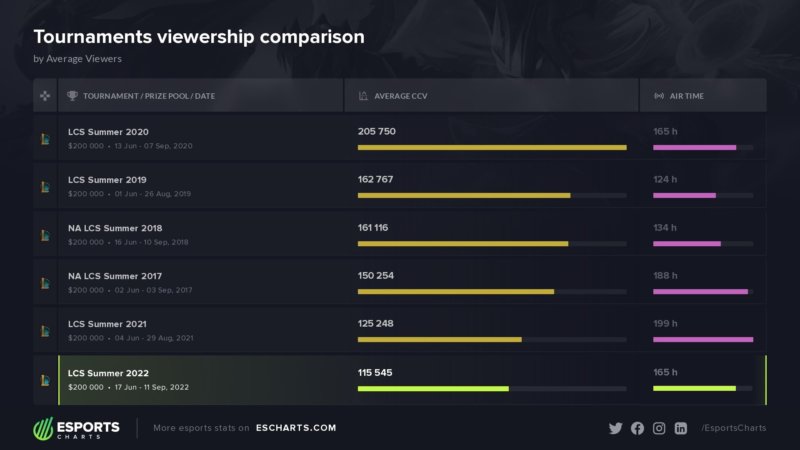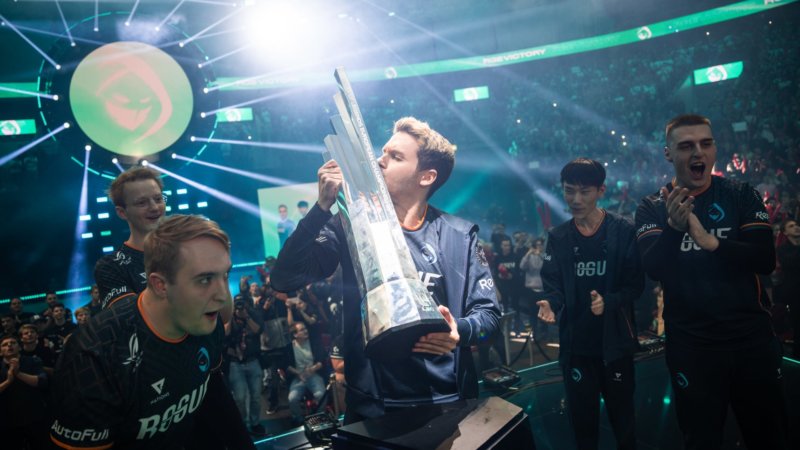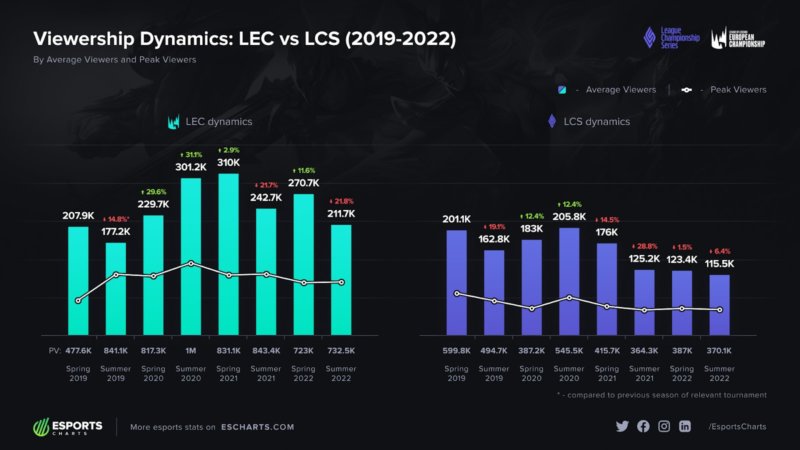The LCS and LEC are both expected to undergo changes heading into the 2023 season. The alterations rumored and confirmed thus far, show a worrying gulf in health and optimism when comparing the current state of each region.

LCS on a slow but steady decline
The LCS’ popularity skyrocketed in its early years, coinciding with the popularity of its professional players. Two giants of the era, TSM and CLG had immense viewership even during regular season matches, bringing together some of the biggest names into one matchup with the likes of Doublelift, Aphromoo, Dyrus, Bjergsen and WildTurtle competing. As these OG figures retire, very few, if any, current players gain the same level of fame in order to keep eyeballs on the league in the same way that the icons were able to.
This lack of personalities, or the league’s inability to showcase them, has been one factor in the now underwhelming sentiment around the League Championship Series The general direction of the broadcast has also previously been called into question; accused of trying too hard to emulate traditional sports shows rather than forge its own identity. Improvements made in this department in recent seasons may have come too late.
Other causes for the LCS’s downturn have also been suggested, including a continued lack of international success. However, regardless of the reasons, the figures paint a bleak picture. Esports Charts indicates that, of the last six LCS summer splits, 2022 had the lowest number of average concurrent viewers (115,545) and second-lowest peak concurrent viewers (370,178).

Source: Esports Charts
Heading into 2023 and BLIX.gg is reporting that the LCS is set to change its gamedays away from the current weekend schedule and instead play matches midweek, likely on Wednesdays and Thursdays, which could cause the already declining viewership to take a further hit.
With the LCS and LEC currently featuring on weekends, Saturday acts as a shared gameday with a slight overlap between the end of the European broadcast and the beginning of the North American. The LCS would usually begin with viewers in the low tens of thousands before a raid from the LEC provides a much-needed boost. As the LEC appears to be sticking to weekends next season, these raids will no longer be a viable tool.
Even genuine, engaged LCS viewers from EU may now find it harder to tune into live broadcasts. With matches on weekdays, the gamedays’ starting time would likely be at an hour suitable for both East and West coast NA viewers to watch after work; ruling out a favourable time for Europe.

Why the change in play days?
This all begs the question of why Riot Games would implement such a switch in the first place. The front-running theory is to make way for the upcoming VALORANT Champions Tour, specifically its Americas League.
VALORANT esports, though not as tenured as League of Legends, is hugely popular in North America. The NA Champions Tour Last Chance Qualifier saw a peak concurrent viewership of 631,664, more than double that of the LCS Summer final a month later. The proposed change would make VCT Americas Riot Games’ sole tier-1 NA esports league viewable on weekends, cutting out one of its biggest competitors. Riot’s position seems clear; sacrifice the LCS to give VCT Americas the best chance at success.
It’s a bold move, one that may make sense to Cloud9, 100 Thieves and Evil Geniuses who will be represented in the VCT Americas and are invested in that league’s growth. However, for the other seven LCS organizations, it’s hard to imagine that this proposed change will go over well, especially remembering that each stumped up at least $10m for their franchise spot. The silver lining is that the change will, presumably, need their signoff before it can go ahead.
LEC on a steady growth curve in comparison
The LEC has seen much healthier viewership. Its summer 2022 final peaked at 732,573 viewers, almost double that of the LCS. While both leagues saw an uptick in viewership during the COVID-19 lockdowns, only the LEC viewership is still up on its 2019 levels.
A multitude of reasons can be attributed to this, one being the focus on broadcast talent and platforming them as micro-influencers by allowing their creativity to flourish through skits and songs. Their content is always centred around the league, helping to both build personal brands as well as shape broadcast narratives.
The solid viewership has resulted in continued optimism in European League of Legends, where slots are still being traded for significant sums. This off season alone saw two new sides enter the mix in Team Heretics and KOI. Furthermore, the LEC Free Agency is the hottest player market in the world.
While the league is, by most accounts, in a healthy place heading into next season, that hasn’t stopped the LEC from undergoing its own changes. As well as adding the Türki̇ye, CIS and MENA regions to the newly-named League of Legends EMEA Championship, the 2023 season is set to see three splits rather than two, with each playing out much differently than the current format.

While Riot’s announcement goes into the minutiae of the new format, the key differences are the addition of more best-of series through BO3 GSL groups, an increase in the overall amount of games played by the best teams and, boldly, far fewer matches for the LEC’s bottom sides.
The best-of-threes bring EMEA closer to par with Korea and China, the two larger and internationally more successful regions. One difference that’s thought to have given Eastern teams an advantage is the sheer amount of on-stage practice gained from having domestic best-of-threes rather than best-of-ones. For comparison, Korea and China’s respective Worlds first seeds played 98 and 107 domestic games this season whilst Europe’s first seed Rogue only played 63.
Adding more best-of matches earlier in the split had been a sticking point for Riot following a failed attempt in EU LCS 2016 Summer. However, on that occasion, they employed an odd best-of-two format that meant games could be tied; a foreign concept in esports.
This time the addition of best-ofs is to be implemented in a far more considered manner through the GSL groups; a format growing in popularity as it eradicates no-stakes games – teams only play as long as they’re continuing to fight for qualification. The lack of dead rubber matches should only help with the region’s viewership, every match will have something on the line and fans must always tune in to see how the league is panning out.

Source: Esports Charts
EU > NA
In the past, the European league often felt like the little sibling to its North American counterpart. NA LCS was the bigger product back then and little was done to allow the EU LCS to stand on its own two feet. In those days, the EU broadcast was even produced from North American studios despite matches taking place in Berlin.
Now the LEC stands alone, it’s been allowed to forge its own identity. Its talent became stars, encouraged to push content that also includes players themselves and helps to share their stories, promote narratives and, ultimately, drive interest in the games. NA’s broadcast has stars of its own, but their talents are best put to use through their own personal content.
LEC format changes break out from the usual two splits per season, innovating in search of a system that will push player development rather than sticking to an arbitrarily normalised schedule. Meanwhile, the LCS is asked to take one for the team to make way for the shiny new VCT, saying it all for the Riot’s confidence in the future of the league.
Article contributed by Lee Jones.
